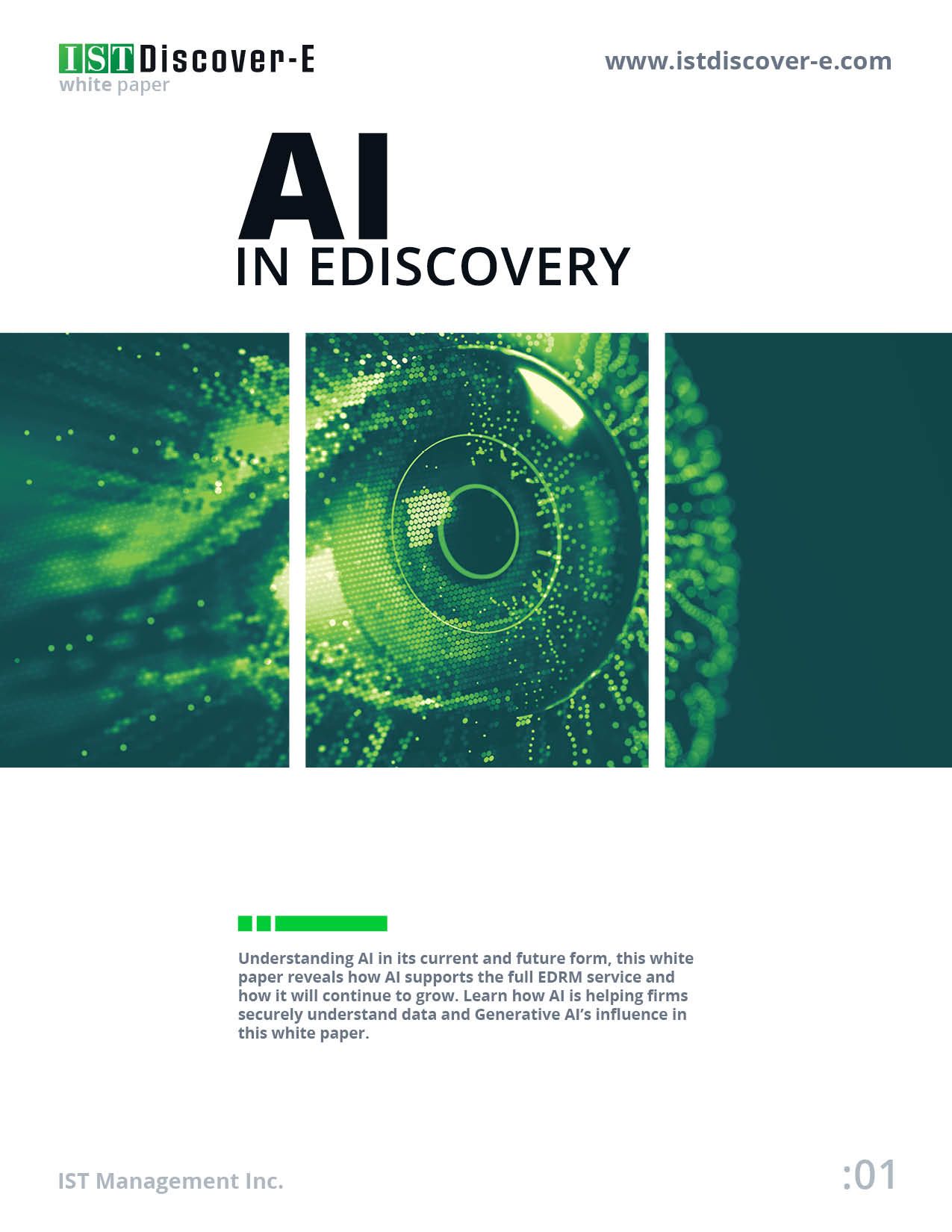AI in eDiscovery
AI or Artificial Intelligence is driving the conversation around eDiscovery and with good reason. New, developing capabilities are enhancing the digestion and interpretation of data. The maturation of AI in eDiscovery couldn’t be better timed as costs to review ever-increasing data sets are reframing attorney's priorities in litigation. AI readily proves it can assist in refining case strategy while reducing preparation and administrative tasks, which makes litigation both efficient and more accessible.
Understandably, with new technology comes growing pains, and in the high-stakes legal world, it has halted some from embracing its potential. Though AI is undoubtedly trending, it is not new to litigation. In fact, numerous AI tools already enhance eDiscovery, so the real challenge is: How is it evolving, and how are legal professionals getting in front of it?
Scaling the Data Giant with Today's AI
Tools for Navigating Data
Many AI tools have already enhanced eDiscovery and have been doing so for many years. Machine Learning (ML), an algorithm-driven function, has existed since the 1940s, yet computer processing and data influx, combined with advances in ML have made it more pressing to wield. Under the umbrella of machine learning, various tools exist to parse and understand data and inform legal strategy. As technology grows, so does the sprawl of data, qualifying these tools as necessary assets to provide a timely and cost-effective service.
Machine Learning enhances well-known tools for document review, including email threading and clustering. These tools organize data through either category (type of email) or related text in multiple documents (clusters). Another tool, concept search, improves keyword searches by submitting a concept to flag relevant documents. Review attorneys can use simple and complex concept phrases to narrow searches to the most pertinent data. Concept search moves beyond the exact keyword to qualify the intent, retaining synonyms and misspellings as extensions of the investigation.
Among the familiar AI functions in eDiscovery is TAR or Technology Assisted Review, a supervised machine learning that trains software using attorney-reviewed sample data sets to distinguish relevant documents. Using Natural Language Processing (NLP), a type of AI, TAR identifies words or phrases and qualifies them based on privilege, relevance, and other details. TAR is typically used with human reviewers and learns throughout the process, making document review more accurate and cost-effective.
Tools Heightening Security
Data sprawl challenges even the most robust data privacy protections, and a few tools currently in use that effectively address this concern include Entity Recognition, Anonymization, and Identity Masking. Entity Recognition pre-determines concepts like places, people, products, etc., using machine learning methods and extracts text into metadata fields. Beyond a faster review, it can reduce risk to distinguish documents with privileged data or Personally Identifiable Information (PII) like social security or credit card numbers. Additionally, protecting this privileged information is Anonymization, which removes PII from data sets, which can then be replaced with equivalent random characters or fake data using Identity Masking. Often, data security intimidates the trust one may place in legal solutions that use AI. The threat of cybersecurity, especially given its complexity under AI, is an understandable reason to pause fully embracing new technology. Still, under the guise of knowledgeable attorneys, these tools are assets to strengthen security in the overall service and combat potential cybercrime.
Tools Understanding Data
Previously AI helped us to better identify relevant information in data sets. As AI continues to mature, it will help us to better understand that data as well. Behavioral analytics used in Sentiment Analysis move beyond the text to conceptualize the behavioral and emotional context, outlining tones and inflections to determine which documents are likely case-specific. Where AI and machine learning have evolved hand in hand, the torch is now passing to AI and machine reasoning.
One may view the behemoth topic of AI in eDiscovery as simply data analysis tools. This known feature may lack the luster of AI's futuristic allure, but the two terms are one and the same. The key is in the word analysis, which a human review attorney completes with the guide of these essential AI tools. With this in mind, AI can be broken down into three pieces: analysis in gathering and in understanding data, and enrichment of understanding it.
The Data Giant Summit- The Future
With the introduction of Language Learning Models (LLMs) like ChatGPT and other Generative AI tools, legal professionals and their clients may feel like they are in a long race to catch up with these applications and seek answers to stay competitive. Though they have a place in the legal world, these technologies are rapidly evolving at the expense of test subjects who are not thoroughly vetting them before use. As with any new tool, the fault lies in the one wielding it. Staying informed in its development is only half of the responsibility. The other half, perhaps more vital, is understanding how to interact with it, using prompts and navigating its complex stack of algorithms.
Like other AI tools, the algorithm determines Generative AI's success. It falls under the umbrella of machine learning and Natural Language Processing (NLP) but is more complex in the stacks of algorithms that work together (called deep learning). In this stacked algorithm, each layer is combined at the next layer, requiring massive amounts of training data to work. As we further understand the layers of algorithms and verify no bias, Gen AI could earn its place in eDiscovery processes. Still, until then, its primary use will likely be a supportive role to attorneys.
Research, marketing, and preparation can all benefit from Gen AI. Attorneys can complete draft outlines and presentations, develop marketing efforts, and supplement case research. Upon further development, it could provide a tangible solution for options to offset the cost of litigation, assist in billing, forecast financial outcomes relative to litigation, analyze briefs, and more.
Why Now?
Just as law firms were once limited to keyword searches and then analytics technology introduced the ability to find themes, recurring words, phrases, or concepts automatically, AI has improved and expanded eDiscovery technology to be able to understand data. The better the technology and data analytics ability, the quicker a firm can reduce costs. Today's legal challenge lies not in AI but in data, which has rapidly outpaced many firm's capabilities.
To illustrate the silent army of data framing potential litigation, a 2023 study in data statistics summarized this monumental challenge by discovering:
- The average person generates 1.7MB of data per second
- 90% of the world's data was created in the last two years
- More than 60% of corporate data worldwide is stored in the cloud
This data, under the lens of modern hybrid and remote work structures, complicates litigation for corporate entities and overwhelms document review teams without the proper tools. AI, applied to these current challenges, can fit in most aspects of the full EDRM service, from identifying relevant content faster, understanding preservation scope, culling of data, and enhancing review and reporting, helping firms and their clients stay ahead of industry demands and drive the conversation.
Adopting and fully embracing these new technologies can be a challenge for firms balancing the in-house expense against service costs to clients. Indeed, firms not considering how to leverage these tools may find themselves playing an endless game of catch-up or worse, fall behind. Under the guidance of an eDiscovery partnership, like that of IST Management, the door opens for AI technology and consultation to apply it defensibly and strategically.
The horror stories of AI don't represent how reliable these technologies are currently in eDiscovery, especially in helping attorneys understand data and develop winning strategies. AI constantly evolves, so its place in eDiscovery will evolve. Understanding these tools and anticipating more incredible applications is vital to receiving the best support from an eDiscovery provider and ensuring you use them to your advantage.




